i have 57 stones in total and diffrent kinds of stones!!!!!!!!!!!!!!!!!!!!!!!!!!!!!!!!!!!!!!!!!!!!!!!!!!!!!!!!!!!!!!!!!!!!!!!!!!!!!!!!!!!!!!!!!!!!!!!!!!!!!!!!!!!!!!!!!!!!!!!!!!!!!!!!
Tuesday, October 25, 2011
Thursday, September 1, 2011
candy crystals that you could eat
How To Grow Sugar Crystals - Make Your Own Rock Candy
Here's How:
- Gather your materials.
- You may wish to grow a seed crystal, a small crystal to weight your string and provide a surface for larger crystals to grow onto. A seed crystal is not necessary as long as you are using a rough string or yarn.
- Tie the string to a pencil or butter knife. If you have made a seed crystal, tie it to the bottom of the string. Set the pencil or knife across the top of the glass jar and make sure that the string will hang into the jar without touching its sides or bottom. However, you want the string to hang nearly to the bottom. Adjust the length of the string, if necessary.
- Boil the water. If you boil your water in the microwave, be very careful removing it to avoid getting splashed!
- Stir in the sugar, a teaspoonful at a time. Keep adding sugar until it starts to accumulate at the bottom of the container and won't dissolve even with more stirring. This means your sugar solution is saturated. If you don't use a saturated solution, then your crystals won't grow quickly. On the other hand, if you add too much sugar, new crystals will grow on the undissolved sugar and not on your string.
- If you want colored crystals, stir in a few drops of food coloring.
- Pour your solution into the clear glass jar. If you have undissolved sugar at the bottom of your container, avoid getting it in the jar.
- Place the pencil over the jar and allow the string to dangle into the liquid.
- Set the jar somewhere where it can remain undisturbed. If you like, you can set a coffee filter or paper towel over the jar to prevent dust from falling into the jar.
- Check on your crystals after a day. You should be able to see the beginnings of crystal growth on the string or seed crytal.
- Let the crystals grow until they have reached the desired size or have stopped growing. At this point, you can pull out the string and allow the crystal to dry. You can eat them or keep them. Have fun!
- If you are having trouble growing sugar crystals, you may want to try some special techniques. A video tutorial showing how to make rock candy is available, too.
Tips:
- Crystals will form on a cotton or wool string or yarn, but not on a nylon line. If you use a nylon line, tie a seed crystal to it to stimulate crystal growth.
- If you are making the crystals to eat, please don't use a fishing weight to hold your string down. The lead from the weight will end up in the water -- it's toxic. Paper clips are a better choice, but still not great.
What You Need
- 1 cup water
- 3 cups table sugar (sucrose)
- clean glass jar
- pencil or butter knife
- string
- pan or bowl for boiling water and making solution
- spoon or stirring rod
Posted by john65 at 6:10 PM 0 comments
Tuesday, July 26, 2011
how gem stones get there color
How Gemstones Get Their Colors 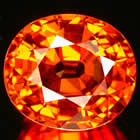 Color is the most important characteristic of gemstones, though in the case of many diamonds it is the absence of color which is most important. But why do the different gemstones have different colors? What's responsible for the variation in color? Color is the most important characteristic of gemstones, though in the case of many diamonds it is the absence of color which is most important. But why do the different gemstones have different colors? What's responsible for the variation in color?Color is produced by the way a gemstone absorbs light. Light is an electromagnetic vibration at certain wavelengths, but the human eye can only perceive wavelengths between 380 and 750 nm. This is the field of the visible color spectrum: red, orange, yellow, green, blue and violet. 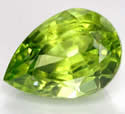 If all the different wavelengths of light pass through a gemstone, it will appear colorless. On the other hand, if the gem material absorbs all light, it will be appear black. But if a stone absorbs all wavelengths except those in the red part of the spectrum, the gem will appear red. If all the different wavelengths of light pass through a gemstone, it will appear colorless. On the other hand, if the gem material absorbs all light, it will be appear black. But if a stone absorbs all wavelengths except those in the red part of the spectrum, the gem will appear red.There are several different reasons why the various gemstone varieties absorb light differently. Some gemstones are said to be idiochromatic or "self-colored", meaning that they absorb certain wavelengths of light due to characteristics of their chemical structure. Peridot, which contains iron, is an example of an idiochromatic gemstone. 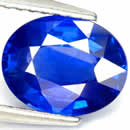 However, idiochromatic gemstones are rare. Most gemstones are allochromatic, meaning that they are colored by impurities or trace elements in their crystal structure. For example, pure corundum is colorless. But corundum is typically red when traces of chromium are present; and blue when there are traces of titanium. We call the former ruby, and the latter sapphire. However, idiochromatic gemstones are rare. Most gemstones are allochromatic, meaning that they are colored by impurities or trace elements in their crystal structure. For example, pure corundum is colorless. But corundum is typically red when traces of chromium are present; and blue when there are traces of titanium. We call the former ruby, and the latter sapphire.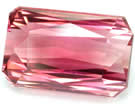 The most common trace elements in gemstones are beryllium (emerald), chromium (emerald, jade, chrome tourmaline, ruby and topaz), copper (paraiba tourmaline, turquoise, malachite), iron (yellow sapphire, aquamarine, green tourmaline, chrysoberyl, citrine, jade), lithium (green or pink tourmaline), manganese (pink tourmaline, morganite, kunzite, spessartite garnet), sulfur (lapis lazuli), titanium (sapphire) and vanadium (emerald, alexandrite, color-change sapphire). The most common trace elements in gemstones are beryllium (emerald), chromium (emerald, jade, chrome tourmaline, ruby and topaz), copper (paraiba tourmaline, turquoise, malachite), iron (yellow sapphire, aquamarine, green tourmaline, chrysoberyl, citrine, jade), lithium (green or pink tourmaline), manganese (pink tourmaline, morganite, kunzite, spessartite garnet), sulfur (lapis lazuli), titanium (sapphire) and vanadium (emerald, alexandrite, color-change sapphire).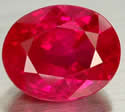 One thing you will notice from this list is that the relation between a chemical impurity and a gemstone color is not a simple one. In some cases, a similar color can result from different trace elements -- the green of an emerald can be the result of chromium or vanadium (or both). In other cases, a single trace element can produce different colors in different gem varieties. Thus chromium will produce a green color in emerald, but produce a red color in corundum. This is because there is a complex relation between the gem's crystal structure and the trace elements. One thing you will notice from this list is that the relation between a chemical impurity and a gemstone color is not a simple one. In some cases, a similar color can result from different trace elements -- the green of an emerald can be the result of chromium or vanadium (or both). In other cases, a single trace element can produce different colors in different gem varieties. Thus chromium will produce a green color in emerald, but produce a red color in corundum. This is because there is a complex relation between the gem's crystal structure and the trace elements. This short survey would not be complete without mentioning another important way in which gemstones acquire color -- through human intervention in the form of gem treatments. Heat treatment, for example, is often used to change the chemical state of an impurity to deepen or lighten color, reduce a certain hue (such as the green tone in aquamarine), or improve clarity. This short survey would not be complete without mentioning another important way in which gemstones acquire color -- through human intervention in the form of gem treatments. Heat treatment, for example, is often used to change the chemical state of an impurity to deepen or lighten color, reduce a certain hue (such as the green tone in aquamarine), or improve clarity. |
First Published: March-11-2008 |
 Color is the most important characteristic of gemstones, though in the case of many diamonds it is the absence of color which is most important. But why do the different gemstones have different colors? What's responsible for the variation in color?
Color is the most important characteristic of gemstones, though in the case of many diamonds it is the absence of color which is most important. But why do the different gemstones have different colors? What's responsible for the variation in color?Color is produced by the way a gemstone absorbs light. Light is an electromagnetic vibration at certain wavelengths, but the human eye can only perceive wavelengths between 380 and 750 nm. This is the field of the visible color spectrum: red, orange, yellow, green, blue and violet.
 If all the different wavelengths of light pass through a gemstone, it will appear colorless. On the other hand, if the gem material absorbs all light, it will be appear black. But if a stone absorbs all wavelengths except those in the red part of the spectrum, the gem will appear red.
If all the different wavelengths of light pass through a gemstone, it will appear colorless. On the other hand, if the gem material absorbs all light, it will be appear black. But if a stone absorbs all wavelengths except those in the red part of the spectrum, the gem will appear red.There are several different reasons why the various gemstone varieties absorb light differently. Some gemstones are said to be idiochromatic or "self-colored", meaning that they absorb certain wavelengths of light due to characteristics of their chemical structure. Peridot, which contains iron, is an example of an idiochromatic gemstone.
 However, idiochromatic gemstones are rare. Most gemstones are allochromatic, meaning that they are colored by impurities or trace elements in their crystal structure. For example, pure corundum is colorless. But corundum is typically red when traces of chromium are present; and blue when there are traces of titanium. We call the former ruby, and the latter sapphire.
However, idiochromatic gemstones are rare. Most gemstones are allochromatic, meaning that they are colored by impurities or trace elements in their crystal structure. For example, pure corundum is colorless. But corundum is typically red when traces of chromium are present; and blue when there are traces of titanium. We call the former ruby, and the latter sapphire. The most common trace elements in gemstones are beryllium (emerald), chromium (emerald, jade, chrome tourmaline, ruby and topaz), copper (paraiba tourmaline, turquoise, malachite), iron (yellow sapphire, aquamarine, green tourmaline, chrysoberyl, citrine, jade), lithium (green or pink tourmaline), manganese (pink tourmaline, morganite, kunzite, spessartite garnet), sulfur (lapis lazuli), titanium (sapphire) and vanadium (emerald, alexandrite, color-change sapphire).
The most common trace elements in gemstones are beryllium (emerald), chromium (emerald, jade, chrome tourmaline, ruby and topaz), copper (paraiba tourmaline, turquoise, malachite), iron (yellow sapphire, aquamarine, green tourmaline, chrysoberyl, citrine, jade), lithium (green or pink tourmaline), manganese (pink tourmaline, morganite, kunzite, spessartite garnet), sulfur (lapis lazuli), titanium (sapphire) and vanadium (emerald, alexandrite, color-change sapphire). One thing you will notice from this list is that the relation between a chemical impurity and a gemstone color is not a simple one. In some cases, a similar color can result from different trace elements -- the green of an emerald can be the result of chromium or vanadium (or both). In other cases, a single trace element can produce different colors in different gem varieties. Thus chromium will produce a green color in emerald, but produce a red color in corundum. This is because there is a complex relation between the gem's crystal structure and the trace elements.
One thing you will notice from this list is that the relation between a chemical impurity and a gemstone color is not a simple one. In some cases, a similar color can result from different trace elements -- the green of an emerald can be the result of chromium or vanadium (or both). In other cases, a single trace element can produce different colors in different gem varieties. Thus chromium will produce a green color in emerald, but produce a red color in corundum. This is because there is a complex relation between the gem's crystal structure and the trace elements. This short survey would not be complete without mentioning another important way in which gemstones acquire color -- through human intervention in the form of gem treatments. Heat treatment, for example, is often used to change the chemical state of an impurity to
This short survey would not be complete without mentioning another important way in which gemstones acquire color -- through human intervention in the form of gem treatments. Heat treatment, for example, is often used to change the chemical state of an impurity to
Posted by john65 at 5:43 PM 0 comments
Saturday, June 25, 2011
how do crystals get there color
Chemicals
Growth Imperfections
Light
Cutting
Posted by john65 at 2:10 PM 0 comments
how to grow great crystals
are general instructions for growing crystals that you can use for most crystal recipes. You can find the recipes and information on crystal structures in the Growing Crystals section. Here are the basics, to get you started and help you troubleshoot problems: 
What Are Crystals?
Crystals are structures that are formed from a regular repeated pattern of connected atoms or molecules. Crystals grow by a process termed nucleation. During nucleation, the atoms or molecules that will crystallize (solute) are dissolved into their individual units in a solvent. The solute particles contact each other and connect with each other. This subunit is larger than an individual particle, so more particles will contact and connect with it. Eventually, this crystal nucleus becomes large enough that it falls out of solution (crystallizes). Other solute molecules will continue to attach to the surface of the crystal, causing it to grow until a balance or equilibrium is reached between the solute molecules in the crystal and those that remain in the solution.
The Basic Technique
- Make a saturated solution.
- Start a garden or grow a seed crystal.
- Continue growth.
Make a Saturated Solution
It's best to start your crystals with a saturated solution. A more dilute solution will become saturated as the air evaporates some liquid, but evaporation takes time (days, weeks). You will get your crystals more quickly if the solution is saturated to begin with. Also, there may come a time when you need to add more liquid to your crystal solution. If your solution is anything but saturated, then it will undo your work and actually dissolve your crystals! Make a saturated solution by adding your crystal solute (e.g., alum, sugar, salt) to the solvent (usually water, although some recipes may call for other solvents). Stirring the mix will help to dissolve the solute. Sometimes you may want to apply heat to help the solute dissolve. You can use boiling water or sometimes even heat the solution on the stove, over a burner, or in a microwave.
Growing a Crystal Garden or 'Geode'
If you just want to grow a mass of crystals or a crystal garden, you can pour your saturated solution over a substrate (rocks, brick, sponge), cover the setup with a paper towel or coffee filter to keep out dust, and allow the liquid to slowly evaporate.
Growing a Seed Crystal
On the other hand, if you are trying to grow a larger single crystal, you will need to obtain a seed crystal. One method of getting a seed crystal is to pour a small amount of your saturated solution onto a plate, let the drop evaporate, and scrape the crystals formed on the bottom to use as seeds. Another method is to pour saturated solution into a very smooth container (like a glass jar) and dangle a rough object (like a piece of string) into the liquid. Small crystals will start to grow on the string, which can be used as seed crystals.
Crystal Growth and Housekeeping
If your seed crystal is on a string, pour the liquid into a clean container (otherwise crystals will eventually grow on the glass and compete with your crystal), suspend the string in the liquid, cover the container with a paper towel or coffee filter (don't seal it with a lid!), and continue to grow your crystal. Pour the liquid into a clean container whenever you see crystals growing on the container.
If you selected a seed from a plate, tie it onto a nylon fishing line (too smooth to be attractive to crystals, so your seed can grow without competition), suspend the crystal in a clean container with saturated solution, and grow your crystal the same way as with seeds that were originally on a string.
Keeping Your Treasures
Crystals that were made from a water (aqueous) solution will dissolve somewhat in humid air. Keep your crystal beautiful by storing it in a dry, closed container. You may wish to wrap it in paper to keep it dry and prevent dust from accumulating on it. Certain crystals can be protected by being sealed with an acrylic coating (like Future floor polish), although applying the acrylic will dissolve the outermost layer of the crystal.
Posted by john65 at 12:32 PM 0 comments
how are diamonds formed
How and where are diamonds formed?
Diamonds form between 120-200 kms or 75-120 miles below the earth's surface. According to geologists the first delivery of diamonds was somewhere around 2.5 billion years ago and the most recent was 45 million years ago. That is a long time, my friend! According to science , the carbon that makes diamonds, comes from the melting of pre-existing rocks in the Earth's upper mantle. There is an abundance of carbon atoms in the mantle. Temperature changes in the upper mantle forces the carbon atoms to go deeper where it melts and finally becomes new rock, when the temperature reduces. If other conditions like pressure and chemistry is right then the carbon atoms in the melting crustal rock bond to build diamond crystals.
There is no guarantee that these carbon atoms will turn into diamonds. If the temperature rises or the pressure drops then the diamond crystals may melt partially or totally dissolve. Even if they do form, it takes thousands of years for those diamonds to come anywhere near the surface.
Are you guys with me? A lot of information, huh! Let's continue!
Diamond's journey to the surface?
Diamond deposits are called Kimberlite Pipes or Blue Ground. These are also called Primary Mines. On the other hand, diamonds are also found at river beds. These are Alluvial Deposits.

So you see that Mother Nature has to toil for millions of years to make a diamond. When you own a piece of diamond, you own something which is a legend in the making. It has not been made in a factory just the other day. A diamond comes from the bosom of the earth. More interestingly not all the diamonds mined are made into jewelry. Only one fourth quantity that is mined is made into jewelry. Every 100 tons of mud produces one carat of a diamond. And might I add, this one carat is not one stone! It could be anything from 0.005 ct to 1 ct..
Would you like to see how a rough diamond looks? This image on your right is an example of a rough diamond. This particular one is called a 'Glassy'. Glassy is a rough diamond that comes out clean from the mines and does not require polishing. It is very rare to get a glassy. Diamonds come in different rough shapes. This one is an octahedron. The next time you look at your diamond, think about the amount of time, energy and resources have gone into making that one. Something for you to ponder about!!!
Posted by john65 at 8:24 AM 0 comments
how do crystals grow in caves
Nucleation
- All crystals form as a result of two processes, called "nucleation" and "crystal growth," in a "supersaturated" liquid solution (a liquid with something dissolved in it; for example, salt). This will occur in a cave if it is flooded with one of these liquid solutions for as long as a hundred thousand years or more. The first step, nucleation, occurs when groups of molecules floating in a solution begin to stick together in stable clusters. Whether a cluster of molecules becomes stable depends on many factors within the solution, including temperature and whether it is "supersaturated."
Supersaturation
- Supersaturation occurs when the solution contains more of the dissolving material than it can dissolve. For example, if you continue stirring sugar into a cup of coffee, the liquid will eventually become "saturated" and unable to dissolve any more sugar. Supersaturation would occur if you added yet more sugar until particles were floating in the coffee, unable to be dissolved.
Crystal Growth
The way the molecules stick together during nucleation plays a role in defining the eventual shape of the crystal. Crystal growth occurs when the stable clusters in the solution achieve critical size (the minimum dimensions the crystal molecules must reach to continue growth without disintegrating). Nucleation continues as crystal growth develops beyond critical size and is driven by supersaturation, providing additional molecules to stick to the nucleus of the fledgling crystal. Depending on conditions within the solution, nucleation or crystal growth may be predominant over the other and result in different-size crystals. Crystal growth or nucleation continues until supersaturation is ended or the cave dries completely.
Different Types of Crystal
- Many different types of solution have the ability to produce different types of crystal. For example, salt crystals occur when salt is dissolved in water and dried, but other materials dissolved in a solution have the ability to form crystals, too. Gallium and halite are other materials known to crystallize.
Making Your Own Crystals
- You can easily form salt crystals at
Posted by john65 at 6:56 AM 0 comments
how do crystals form
Question: How do crystals form? ---Dave
Answer:
Crystals usually form from molten rock as the molten
rock gradually cools. If the molten rock
cools very rapidly, then either small crystals
form or no crystals form. An example of this
is when lava is ejected from a volcano. If
molten rock cools slowly, then large crystals
can form. This happens usually when the molten
material is very deep in the Earth. Examples
of these types of crystals are diamonds, emeralds,
rubies, etc.Crystals can also form when water evaporates.
For example, salt crystals (sodium chloride) form
when salt water evaporates.
The smooth faces of crystals are caused by
a regular internal arrangement of atoms.
-Grant
Posted by john65 at 6:47 AM 0 comments
Information about rose quartz
ROSE QUARTZ: is one of the more desirable varieties of quartz. The pink can be almost rose red and some African verities border on lavender. The color seems to be caused by iron and titanium impurities. However the color of rose quartz is still not completely understood. It has
been said to be due to a number of different minor impurities present in the rose quartz including titanium, manganese and even colloidal gold. However, recent studies using micro-analytical methods have discovered that the color of massive rose quartz is actually due to microscopic mineral fibers in the rose quartz. X-ray diffraction tests on these microscopic fibers yielded patterns similar to the mineral dumortierite but slightly different, suggesting
the possibility of a totally new and as yet unknown fibrous mineral causing the color in massive rose quartz. The rare transparent euhedral crystals of rose quartz owe their coloration to aluminum and phosphorous impurities. The pink color in Rose Quartz is photosensitive and
can fade in sunlight.
USES:Rose quartz is used as an ornamental stone and as a gemstone. Rose Quartz is usually, but not always, too cloudy to be used as a cut gemstone. Most gemmy rose quartz is used as cabochons where the clarity is not as important as the color. Rose quartz is also a very attractive ornamental stone and is carved into popular spheres, pyramids, obelisks, figurines and ornate statues.
BACKGROUND INFORMATION:
Rose Quartz is almost always massive, rarely occurring in small horizontally striated hexagonal prisms . Scientifically, there is no reason why Rose Quartz does not occur more commonly in crystals. This remains a scientific mystery. Because quartz crystallizes into well formed crystals in all its other macroscopic varieties. Brazil is also the only source of true well formed crystals of rose quartz. Rose Quartz crystals are thus extremely valuable.
If rutile needles are present in the rose quartz then a star effect or asterism is sometimes seen. The star is best seen when light is viewed through the rose quartz. This is different from asterisms in most other gemstones, such as ruby and sapphire, where the stars are seen when light is shown on the gems
OCCURRENCE:
Rose quartz is found in Madagascar, India, Germany and several localities in the USA. Much rose quartz was extracted from a famous site near Custer, South Dakota, but now, most of the worlds supply of good carvable rose quartz comes from Brazil. Rose quartz is only one of several quartz varieties. Other varieties that form macroscopic (large enough to see) crystals are as follows: Amethyst is the purple gemstone variety. Citrine is a yellow to orange gemstone variety that is rare in nature but is often created by heating Amethyst. Milky Quartz is the cloudy white variety. Rock crystal is the clear variety that is also used as a gemstone. Smoky quartz is the brown to gray variety.
HISTORICAL INFORMATION:
Rose quartz has been used as a gemstone and as other ornamental and religious objects for thousands of years. Historically, it is a symbol of love and beauty. The name quartz comes from the Saxon word querklufterz which meant cross vein ore. The astrological signs of rose quartz are Taurus and Libra.
Posted by john65 at 6:27 AM 0 comments
How Do Smoky Cyrstal Quartz Form ?
Found in granite mountains that have small but persistent levels of radioactivity. Smoky quartz usually contains aluminum impurities that turn the quartz smoky gray when exposed to radioactivity. If enough aluminum is present, the quartz can turn completely black, and is called "morian". When treated with extremely high temperatures, the quartz will return to a clear form.
Two thousand years ago, a Roman scholar known as Pliny the Elder suggested that quartz might be permanently frozen ice, because it was often found near glaciers. His idea remained popular until the scientific revolution in the eighteenth century. Quartz is actually silicon dioxide, a combination of silicon and oxygen, the two most abundant elements in earth's crust, and is found in virtually every type of known rock type, including igneous, sedimentary, metamorphic, meteorites, and lunar rocks. Pure silicon dioxide is clear, but impurities can cause it to be many different colors. The various colors of quartz are often given different names: amethyst (purple color - iron and magnesium impurities)
Posted by john65 at 6:07 AM 0 comments

